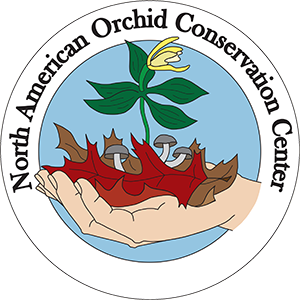Small Whorled Pogonia
Federally Threatened
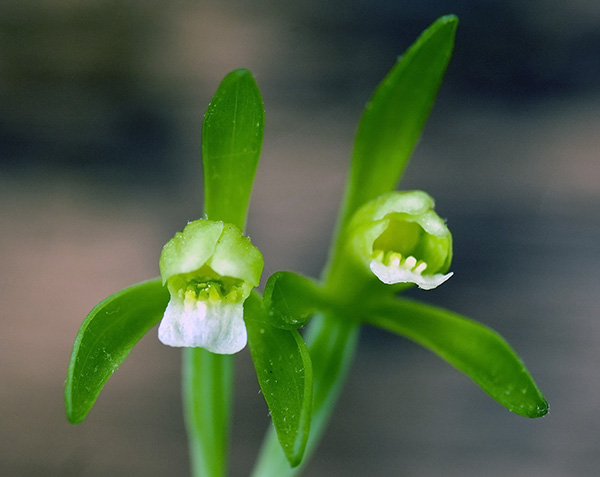
Often cited as "the rarest orchid east of the Mississippi," the status of the Small Whorled Pogonia (Isotria medeoloides) has actually improved as searches for this orchid have turned up new locations and ongoing management experiments are revealing much about its biology and the best methods for its conservation. Still the majority of its populations typically number fewer than 25 plants, and are thus vulnerable to local extinction. The primary threat to this orchid’s survival is destruction of its woodland habitat for development.
Photo © David McAdoo

![]()
![]()
Small Whorled Pogonia
Federally Threatened
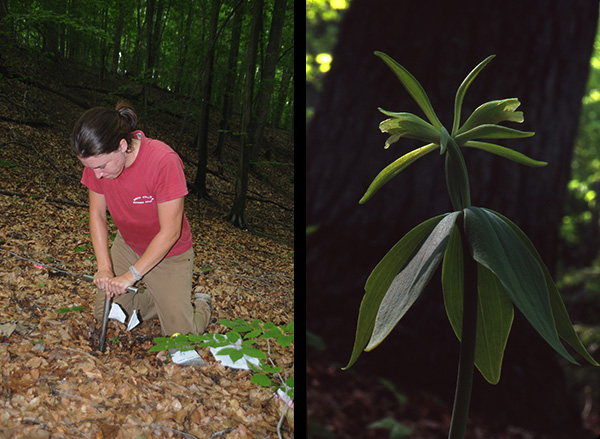
As a graduate student at the University of Connecticut, Rachel Rock-Blake collaborated with staff at the Smithsonian Environmental Research Center and New Hampshire’s Natural Heritage Bureau to investigate the interaction between fungi associated with trees and Isotria medeoloides. Declines in this orchid’s populations are usually preceded by an increased frequency and duration of years when the orchids are alive, but fail to emerge aboveground. She observed that these orchids were more likely to emerge aboveground when the fungi they use were more abundant in the soil nearby. Management plans that include the trees that support Isotria’s mycorrhizal fungi may be effective to help this orchid’s populations recover.
Photo © Melissa McCormick (l), ©William Moye (r)

![]()
![]()
Ute Ladies’ Tresses
Federally Threatened
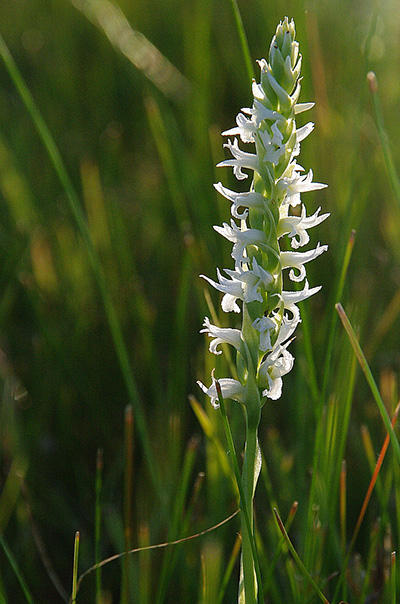
The Ute Ladies' Tresses (Spiranthes diluvialis) is native to the western United States and has recently been discovered in British Columbia. The species name diluvialis means “of the flood” - appropriate for an orchid that can be found in flood-prone river habitats. Even though new populations continue to be discovered, this orchid remains threatened because riparian habitats are being drastically modified as water is diverted for irrigation and municipal use, and sites drained and converted to agriculture.
Photo © Steve Ripple
![]()
![]()
![]()
Ute Ladies’ Tresses
Federally Threatened

“Here she is!” Local botanist Frank ‘Buddy’ Smith points out this elusive orchid to volunteer Jesse Walker, at the only known population in the Cache Valley near Logan, Utah. Ute Ladies’ Tresses relies on natural cycles of disturbance, such as flooding and occasional wildfire, to keep its habitat from being overgrown with large and woody vegetation. The Bear River Conservancy has recently established a 30 acre preserve here to conserve the population discovered in 2008.
Photo © Tom Nelson
![]()
![]()
![]()
Western Prairie Fringed Orchid
Federally Threatened
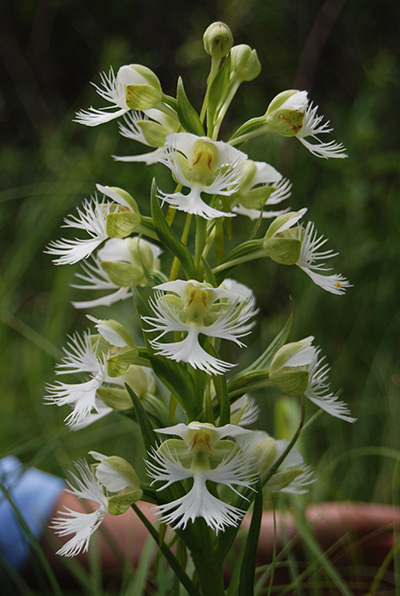
The Western Prairie Fringed Orchid (Platanthera praeclara) is a tall, showy orchid whose fate is closely tied to the North American tallgrass prairies. This orchid prefers the moist soils and direct sunlight of open prairies and sedge meadows. Prairie habitat has been largely converted to cropland or commercially developed, restricting this orchid to less than two per cent of its former range. Inappropriate management of remaining grasslands may also threaten this orchid. Annual mowing may remove seed capsules before they are ripe, leading to reproductive failure.
Photo © Marge From
![]()
![]()
![]()
Western Prairie Fringed Orchid
Federally Threatened

Today this orchid is restricted to scattered, and often isolated populations across 6 US states and Manitoba in Canada. Marge From, with the Omaha Henry Doorly Zoo & Aquarium and Mel Nenneman, from US Fish & Wildlife Service, check plants to estimate reproductive success in the sand hills of Nebraska. Marge’s research included the successful germination of this orchid in the laboratory. One seedling (left) was transferred from the laboratory to the field site and recently flowered. Her research on this orchid’s mycorrhizal associates and soil microbial community may provide insights into some of the orchid’s environmental requirements.
Photo © Marge From (l, upper right), ©Kathy Roccaforte (lower right)
![]()
![]()
![]()
Yadon’s Rein Orchid
Federally Endangered
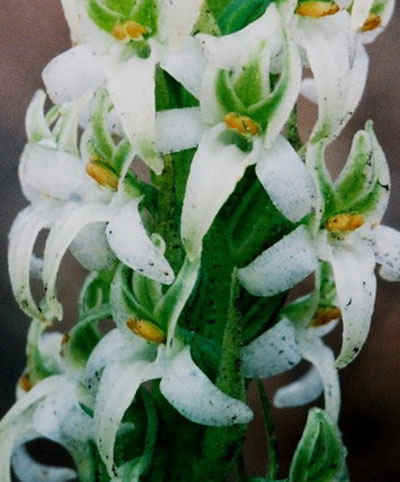
Yadon’s Rein Orchid, Platanthera yadonii (Syn. Piperia yadonii), is restricted to a single California county within a biodiversity hotspot. This orchid can be identified by its distinctive pattern of green and white markings on the flowers and its relatively short nectar spur. Although threatened by habitat destruction that includes golf course construction and urban development, the Assessment of Rare Plants in California (2012) lists this orchid as one of two plants “extremely vulnerable to climate change with the likelihood of substantial decline or extinction by 2050”.
Photo © Tom Nelson
![]()
![]()
![]()
Yadon’s Rein Orchid
Federally Endangered
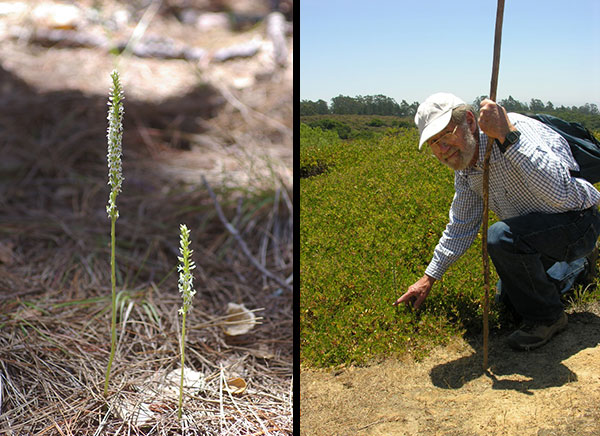
Platanthera yadonii occurs in two distinct habitats. On the right, botanist Vern L. Yadon points out the orchid that bears his name (Platanthera yadonii) in its maritime chaparral habitat. This orchid can also be found in open coastal forests of Monterey pine (l). Drs. Sheeja George and Jyotsna Sharma (Texas Tech University) detected little genetic variation among its populations and among individuals within a population. This loss of diversity may reduce the orchid’s ability to adapt to change. Preserving and expanding the habitat at these sites may be crucial to this orchid’s survival.
Photo © Mark Larocque (l) ©Jyotsna Sharma (r)
![]()
![]()
![]()
Hawaiian Bog Orchid
Federally Endangered
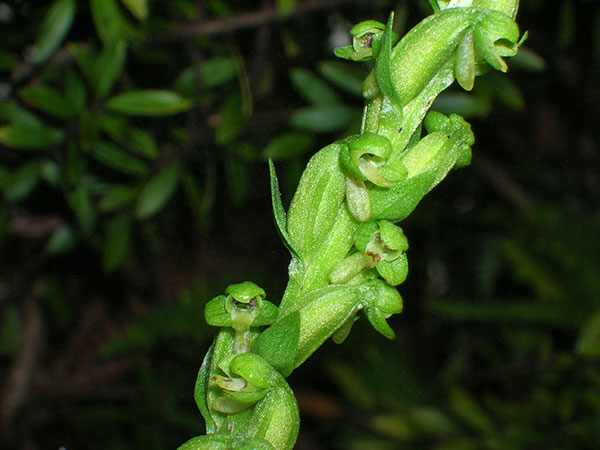
The Hawaiian Bog Orchid, Peristylus holochila (Syn. Platanthera holochila) is perhaps the rarest terrestrial orchid in North America. As of early 2011, only 33 plants were known to occur scattered on three islands in the Hawaiian archipelago (Kauai, Maui, Molokai). The largest population, located on Molokai, is surrounded by a fence for protection from feral pigs, the main threat to the survival of this orchid. Other threats include damage to the habitat by cattle and the invasion of introduced plants.
Photo © Steve Perlman
![]()
![]()
![]()
Hawaiian Bog Orchid
Federally Endangered
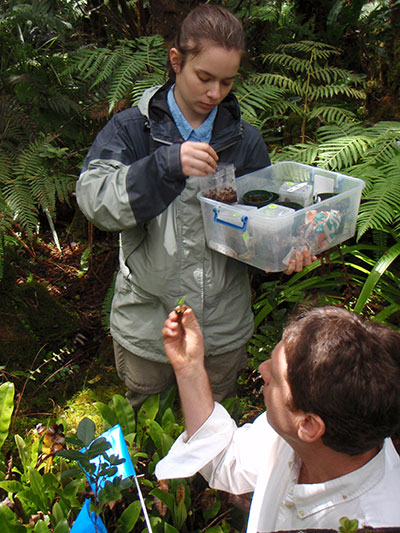
Peristylus holochila seedlings grown by undergraduate students at Illinois College have been transplanted to natural sites and rare plant facilities in Hawaii. Three of these plants have since flowered. Efforts are underway to isolate this orchid’s mycorrhizal fungi which may speed up the propagation process. Illinois College student, Erin Wood, and Dr. Lawrence W. Zettler are shown reintroducing the orchid seedlings on Molokai.
Photo © Steve Perlman
![]()
![]()
![]()
Canelo Hills Ladies’ Tresses
Federally Endangered

Endemic to only four cienega (isolated freshwater marshlands) in southern Arizona, the Canelo Hills Ladies’ Tresses (Spiranthes delitescens) is a short-lived orchid distinguished by its creamy white flowers with downward curving sepals and prominent pubescence. Threats to this orchid include loss of the cienega habitat- already considered one of North America’s most endangered communities.
Photo © Ron Coleman
![]()
![]()
![]()
Canelo Hills Ladies’ Tresses
Federally Endangered
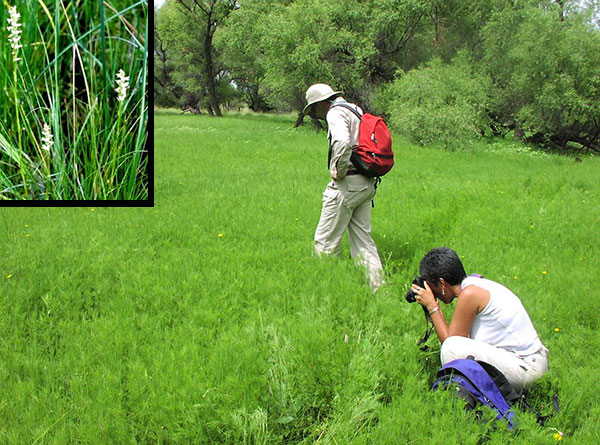
The Nature Conservancy has purchased property encompassing two of the four known populations of Spiranthes delitescens. Nearly impossible to locate when not in flower, Mima Falk and Doug Duncan wait until mid-summer to visit this cienega to photograph and census this endangered orchid. Researchers at the University of Arizona have successfully grown seedlings that have flowered in cultivation, and Desert Botanical Garden and Arizona State University plan to monitor known populations and assess the overall health of this orchid’s habitat.
Photo © Peter Warren, © Jim Rorabaugh (inset)
![]()
![]()
![]()
Eastern Prairie Fringed Orchid
Federally Threatened
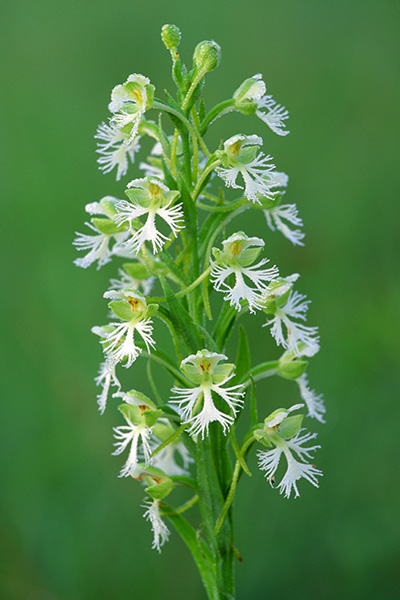
The Eastern Prairie Fringed Orchid (Platanthera leucophaea) is a large, showy, but short-lived orchid native to the grasslands of North America. Although loss of habitat continues to be the biggest threat to this orchid, it is believed that the wide-scale use of insecticides may negatively impact hawkmoths, this orchid’s only known pollinator.
Photo © Michael Redmer, US Fish & Wildlife

![]()
![]()
Eastern Prairie Fringed Orchid
Federally Threatened

Orchid populations that consist of short-lived individuals must rely on the annual production of seeds to survive. The decline of natural pollinators suggests that hand pollination may be key to the survival of the Eastern Prairie Fringed Orchid. Studies show seed quality is improved when this orchid is cross-pollinated. Using a toothpick to transfer pollen to the stigma, a team of Wisconsin landowners and volunteers from the Swamplovers Foundation learn the art of hand pollination under the direction of US Fish & Wildlife staff.
Photo © Cathy Pollack, US Fish & Wildlife

![]()
![]()
Navasota Ladies’ Tresses
Federally Endangered

The Navasota Ladies' Tresses (Spiranthes parksii) is a terrestrial orchid endemic to the post oak savannah in central east Texas. The small cream-colored flowers appear in the fall, and the white-tipped bracts often distinguish this orchid from other species of Spiranthes. Urban development of a landfill threatened 100 acres of habitat and posed an immediate danger to over 300 individuals of this orchid.
Photo © J. Ryan Hammons
![]()
![]()
![]()
Navasota Ladies’ Tresses
Federally Endangered

As a graduate student at Texas A&M University, Ryan Hammons worked with other students and volunteers to characterize the habitat of Spiranthes parksii and identify suitable sites to relocate orchids threatened by the landfill. Historically, the post oak savannah was an ecosystem that was maintained by frequent fires and grazing by bison. Part of Ryan’s efforts was to recommend a management policy that would maintain habitat quality by preventing the development of a dense woody understory that would shade out the orchids.
Photo © J. Ryan Hammons
![]()
![]()
![]()

